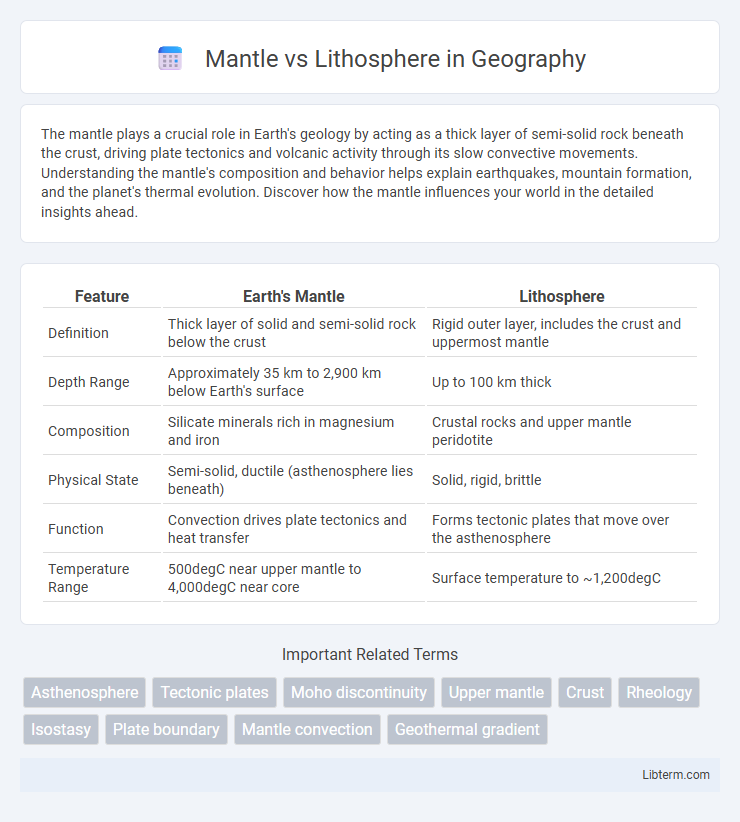The mantle plays a crucial role in Earth's geology by acting as a thick layer of semi-solid rock beneath the crust, driving plate tectonics and volcanic activity through its slow convective movements. Understanding the mantle's composition and behavior helps explain earthquakes, mountain formation, and the planet's thermal evolution. Discover how the mantle influences your world in the detailed insights ahead.
Table of Comparison
| Feature | Earth's Mantle | Lithosphere |
|---|---|---|
| Definition | Thick layer of solid and semi-solid rock below the crust | Rigid outer layer, includes the crust and uppermost mantle |
| Depth Range | Approximately 35 km to 2,900 km below Earth's surface | Up to 100 km thick |
| Composition | Silicate minerals rich in magnesium and iron | Crustal rocks and upper mantle peridotite |
| Physical State | Semi-solid, ductile (asthenosphere lies beneath) | Solid, rigid, brittle |
| Function | Convection drives plate tectonics and heat transfer | Forms tectonic plates that move over the asthenosphere |
| Temperature Range | 500degC near upper mantle to 4,000degC near core | Surface temperature to ~1,200degC |
Understanding the Earth's Internal Structure
The Earth's internal structure consists primarily of the crust, mantle, and core, with the lithosphere encompassing the rigid outer layer including the crust and uppermost mantle. The mantle, extending from the base of the crust to the outer core, is composed of semi-solid rock that flows slowly, driving plate tectonics beneath the lithosphere. Understanding the distinction between the lithosphere and mantle is crucial for geoscience studies related to seismic activity, mantle convection, and Earth's thermal dynamics.
What is the Lithosphere?
The lithosphere is the rigid outer layer of the Earth, comprising the crust and the uppermost part of the mantle. It is divided into tectonic plates that float on the more ductile asthenosphere beneath. This layer plays a critical role in geological processes such as earthquakes, mountain formation, and volcanic activity.
Defining the Mantle
The mantle is a thick, semi-solid layer of Earth located between the crust and the outer core, composed primarily of silicate minerals rich in magnesium and iron. It extends approximately 2,900 kilometers in depth and exhibits convection currents that drive plate tectonics. Unlike the rigid lithosphere, the mantle's plasticity allows it to flow slowly over geological time scales, facilitating mantle convection and contributing to volcanic activity.
Composition: Mantle vs Lithosphere
The mantle is composed primarily of ultramafic peridotite rich in magnesium and iron, while the lithosphere includes both the uppermost mantle and the overlying rigid crust composed of silicate minerals such as granite and basalt. The mantle's chemical composition is dominated by olivine and pyroxene minerals, contributing to its ductile and plastic behavior. In contrast, the lithosphere's composition varies vertically, with a rigid, brittle crust layer formed mainly of feldspar and quartz above the more ductile upper mantle segment.
Physical Properties and States
The mantle consists of solid but ductile rock that behaves plastically over geological time, allowing convection currents, while the lithosphere is rigid and brittle, comprising the Earth's crust and uppermost mantle. The mantle extends to a depth of about 2,900 kilometers, exhibiting increased temperature and pressure causing gradual rock softening, whereas the lithosphere averages 100 kilometers thick and maintains its solid and brittle state. Differences in mechanical strength and temperature gradients between these layers influence tectonic plate movement and seismic activity.
Role in Plate Tectonics
The mantle, particularly its asthenosphere layer, enables the movement of tectonic plates by providing a ductile, convecting region beneath the rigid lithosphere. The lithosphere, composed of the crust and uppermost mantle, forms the solid plates that interact at boundaries causing earthquakes, volcanic activity, and mountain formation. Plate tectonics is driven by mantle convection currents that facilitate the creation, destruction, and lateral movement of lithospheric plates.
Boundary: Lithosphere-Asthenosphere Distinction
The boundary between the mantle and lithosphere, known as the Lithosphere-Asthenosphere Boundary (LAB), is characterized by a distinct mechanical and rheological contrast where the rigid, brittle lithosphere overlies the ductile, flowing asthenosphere. Temperature and pressure variations at this boundary lead to a change from elastic behavior in the lithosphere to viscous, plastic deformation within the upper mantle's asthenosphere. Seismic velocity and attenuation studies reveal this transition zone, crucial for understanding plate tectonics and mantle convection dynamics.
Temperature and Pressure Variations
The mantle experiences significantly higher temperatures and pressures compared to the lithosphere, with mantle temperatures ranging from approximately 500degC near the upper boundary to over 4000degC near the core-mantle boundary and pressures increasing with depth up to around 140 GPa. In contrast, the lithosphere, comprising the crust and uppermost mantle, maintains lower temperatures typically below 1300degC and experiences pressures less than about 3-5 GPa. This temperature and pressure gradient defines the mechanical behavior differences, where the lithosphere remains rigid and brittle, while the mantle behaves plastically and undergoes convection.
Significance in Earth's Geological Processes
The mantle, a highly viscous layer beneath the Earth's crust, drives plate tectonics by generating convection currents that cause lithospheric plates to move. The lithosphere, comprising the rigid crust and upper mantle, forms the Earth's surface plates whose interactions shape geological phenomena such as earthquakes, volcanic activity, and mountain building. Understanding the dynamic relationship between the mantle's heat transfer and lithospheric rigidity is essential for comprehending Earth's geological processes and the planet's evolution.
Key Differences: Mantle vs Lithosphere
The mantle is a thick layer of semi-solid rock beneath the Earth's crust extending to about 2,900 kilometers deep, characterized by slow convection currents driving plate tectonics. The lithosphere comprises the Earth's crust and the uppermost solid part of the mantle, averaging 100 kilometers in thickness, and is rigid and brittle, broken into tectonic plates. Key differences include composition, physical state, depth, and role in geodynamics, with the mantle being ductile and responsible for mantle convection, while the lithosphere acts as a solid, rigid shell supporting tectonic plates.
Mantle Infographic

 libterm.com
libterm.com